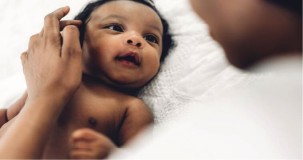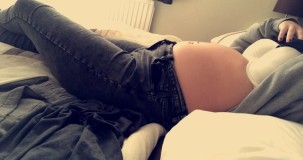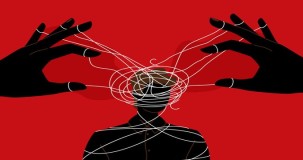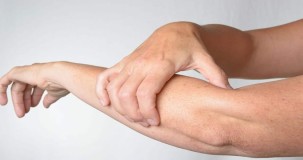What does a baby look like at 21 weeks? At 21 weeks, a baby is about the size of a carrot and weighs around 10 ounces. Their features continue to develop, with tiny eyebrows, eyelashes, and fingernails forming.
Size and Weight: At 21 weeks, a baby typically measures around 10.5 inches from head to toe and weighs about 12.7 ounces. Although still small, the baby has reached a significant milestone in terms of size and weight.
Facial Features: The baby's facial features continue to develop at this stage. Their eyebrows and eyelashes begin to grow, and their tiny eyelids, previously fused shut, can now open and close. Additionally, the baby's lips become more distinct, and they may even suck their thumb in ultrasound images.
Skin and Hair: The baby's skin is still translucent and thin, but it starts to take on a more opaque appearance as fat begins to accumulate beneath it. While the skin remains wrinkled, it becomes less transparent as pigment production increases. The hair on the baby's scalp is also growing, and by this stage, it can have color and texture.
Skeletal System: The skeleton of a 21-week-old baby is made largely of cartilage, but it continues to ossify as it transforms into bone. This ongoing process enables the baby to develop stronger and more defined limbs. X-ray images can reveal the forming bones, including the tiny ribs and spine.
Organs: By this stage, major organ systems are functional, although they continue to refine and mature. The baby's digestive system is developing rapidly, and their intestines begin to absorb small amounts of sugar from the amniotic fluid they swallow. The kidneys are also functioning and producing urine, which contributes to the amniotic fluid as well.
Movements: The baby's movements become more coordinated and deliberate at 21 weeks. As their limbs grow stronger, they can kick, stretch, and even perform somersaults in the womb. These movements are important for the baby's neurological development and also provide reassurance to the expectant mother.
Sensory Development: The baby's sensory organs continue to develop. They may start to hear sounds from the outside world, such as the mother's voice or external noises. The baby's taste buds are also forming, preparing them for the flavors they will experience once they are born.
Sexual Differentiation: By 21 weeks, the baby's genitals have developed to a point where they may be identifiable through ultrasound. If the parents wish to know the baby's sex, this is the stage where it can usually be determined.
Position: At 21 weeks, the baby is still relatively small compared to later stages of pregnancy, allowing them to move around freely in the amniotic fluid. They may assume different positions, such as somersaulting, curling up, or stretching out. However, as they grow, they will gradually adopt a more head-down position in preparation for birth.
Overall Appearance: As the baby's growth progresses, they begin to display a more proportional body shape. Their arms and legs lengthen, and they become more defined. The facial features become clearer, and the baby starts to resemble a newborn, albeit on a smaller scale.
It is important to note that every fetus develops at its own pace, and there can be variations in the growth and development process. The information provided here is a general overview of what a baby may look like at 21 weeks of pregnancy.
At 21 weeks, a baby is about the size of a banana and weighs around 10 ounces (280 grams). They have developed distinct facial features, including eyebrows and eyelids. Their skin is transparent and thin, allowing blood vessels to show through. The baby's body is covered in fine hair called lanugo, and they are beginning to develop taste buds.
What movements can a baby make at 21 weeks?By 21 weeks, a baby's movements are becoming more coordinated. They can kick, stretch, and even do somersaults inside the womb. Some mothers may start feeling their baby's movements, known as quickening, around this time.
Is it possible to determine the baby's gender at 21 weeks?Yes, it is often possible to determine the baby's gender during an ultrasound scan at 21 weeks. The genitals of the baby become more visible at this stage, allowing the sonographer to identify whether it's a boy or a girl. However, it is important to note that not all pregnancies will have an ultrasound examination at this time.
What are the major milestones at 21 weeks of pregnancy?At 21 weeks, the baby's digestive system is starting to work as they swallow amniotic fluid and pass it as urine. The baby's bone marrow is now producing red blood cells, taking over this function from the liver and spleen. Their hearing is also becoming more developed, and they can start recognizing their mother's voice.
How is the baby's brain developing at 21 weeks?At 21 weeks, the baby's brain is rapidly developing. The neurons are forming connections and the brain is undergoing significant growth. The cerebral cortex, responsible for higher thinking, is developing its characteristic wrinkles. The brain is also beginning to control some of the baby's movements and reflexes.
 LATEST ARTICLES
LATEST ARTICLES

Am I a Millennial or Gen Z?

Am I bloated or fat?

Am I dehydrated or sick?

Are babies born with ADHD?

Are babies born geniuses?

Are babies born in September smarter?

Are babies actually talking when they babble?

What are 3 signs of a toxic relationship?

What are 10 signs of a toxic relationship?

Am I in a toxic relationship?

How do you find red flags in a toxic relationship?

Am I bloated or pregnant?

Am I bloated or showing at 9 weeks?

Am I bloated or showing at 10 weeks?

Am I bloated or showing at 7 weeks?

Are acai bowls just smoothies?

Are all pumpkins good for soup?

Are acai bowls healthy or unhealthy?

Are air fried potatoes healthy?

Are albondigas the same as meatballs?

Am I being Gaslit or am I the gaslighter?

Am I bloated or did I gain weight?

Am I allergic to vodka?
 POPULAR ARTICLES
POPULAR ARTICLES

Am I a Millennial or Gen Z?

Am I bloated or fat?

Am I dehydrated or sick?

Are babies born with ADHD?

Are babies born geniuses?

Are babies born in September smarter?

Are babies actually talking when they babble?

What are 3 signs of a toxic relationship?

What are 10 signs of a toxic relationship?

Am I in a toxic relationship?